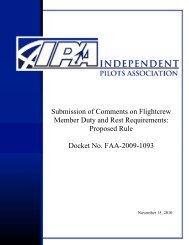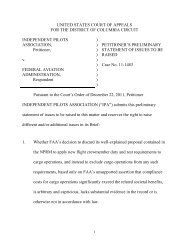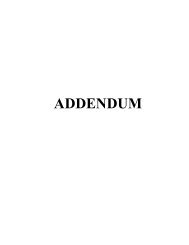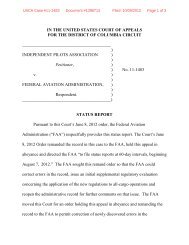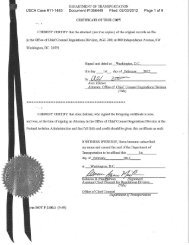Exhibits Vol 2 - Independent Pilots Association
Exhibits Vol 2 - Independent Pilots Association
Exhibits Vol 2 - Independent Pilots Association
You also want an ePaper? Increase the reach of your titles
YUMPU automatically turns print PDFs into web optimized ePapers that Google loves.
scientific correspondence<br />
1. Woodcock, L. V. Nature 385, 141–143 (1997).<br />
2. Alder, B. J., Hoover, W. G. & Young, D. A. J. Chem. Phys. 49,<br />
3688–3696 (1968).<br />
3. Alder, B. J., Carter, B. P. & Young, D. A. Phys. Rev. 183, 831–833<br />
(1969).<br />
4. Alder, B. J., Young, D. A., Mansigh, M. R. & Salsburg, Z. W.<br />
J. Comp. Phys. 7, 361–366 (1971).<br />
5. Young, D. A. & Alder, B. J. J. Chem. Phys. 60, 1254–1267 (1974).<br />
6. Frenkel, D. & Ladd, A. J. C. J. Chem. Phys. 81, 3188–3193<br />
(1984).<br />
7. Pusey, P. N. et al. Phys. Rev. Lett. 63, 2753–2756 (1989).<br />
8. Bolhuis, P. G. & Frenkel, D. J. Chem. Phys. 106, 666–687 (1997).<br />
9. Frenkel, D. & Smit, B. Understanding Molecular Simulation<br />
(Academic, Boston, 1996).<br />
10.Broughton, J. Q. & Gilmer, G. H. J. Chem. Phys. 79, 5095–5104<br />
(1983).<br />
Metallothionein in snail<br />
Cd and Cu metabolism<br />
Terrestrial snails tolerate elevated concentrations<br />
of cadmium and copper, accumulating<br />
both metals in their soft tissues 1 . The<br />
snails are able to inactivate the toxic cadmium<br />
while meeting their metabolic requirement<br />
for copper. Here we report evidence<br />
for the metabolic discrimination between<br />
the two metals based on the existence of<br />
distinct metallothionein isoforms, one<br />
dedicated to cadmium detoxification and<br />
another to copper regulation.<br />
Even snails living in relatively unpolluted<br />
environments have the exceptional abili-<br />
Figure 1 Primary structures of the cadmium- and<br />
copper-binding metallothionein isoforms from the<br />
midgut gland and mantle of H. pomatia. Residues<br />
are indicated using single-letter code, with cysteines<br />
in black. The N termini are acetylated (Ac).<br />
Substituted residues are indicated in grey in the<br />
copper-binding isoform. The cadmium-binding isoform<br />
was purified and sequenced as described earlier<br />
5 . The copper-binding isoform was purified from<br />
mantle tissue by combined gel permeation, ionexchange<br />
chromatography, and reversed-phase<br />
HPLC. After endoproteinase digestion (trypsin, Lys-C<br />
and Arg-C) of S-methylated protein, peptides were<br />
sequenced by collision-induced tandem mass<br />
spectrometry (API III, Sciex, Canada) using argon as<br />
the collision gas (410 14 molecules cm 2 ).<br />
Figure 2 a, Linear relationship (bold line; regression<br />
coefficient r0.96), with 95% confidence limits<br />
(hatched lines) between molar concentrations (on a<br />
tissue dry-mass basis) of Cd and Cd–metallothionein<br />
(Cd–MT) in the midgut gland of H. pomatia fed<br />
on a Cd-enriched diet (3.5–955 g Cd per g dry<br />
mass) for 14 days. b, Molar concentrations of Cd,<br />
Cu, and Cu–metallothionein (Cu–MT) in the mantle<br />
of H. pomatia after feeding the animals on uncontaminated<br />
salad (control) or on Cd-enriched (Cd-fed;<br />
260 g per g dry weight) or Cu-enriched diets (Cufed;<br />
530 g per g dry weight) for 14 days. Mean<br />
concentration±s.d. (n7). Asterisks indicate significant<br />
differences (P0.01) from control values (Student’s<br />
t-test). Concentrations of Cd–metallothionein<br />
and Cu–metallothionein were determined by modified<br />
Cd- and Cu-saturation assays 11 (removing Cu<br />
from the holo-metallothionein with ammoniumtetrathiomolybdate).<br />
Similar results (not shown)<br />
were obtained after injecting Cd and Cu into mantle<br />
tissue.<br />
ty to concentrate cadmium — more than<br />
many other terrestrial invertebrates — in<br />
the midgut gland 2 . In contrast, copper,<br />
which is an essential constituent of the oxygen-carrying<br />
protein haemocyanin 3,4 , is<br />
predominantly present in the snail’s foot<br />
and mantle 1 . The concentration of copper is<br />
kept constant, with animals quickly eliminating<br />
any excess that may have entered the<br />
tissue after environmental exposure 1 . We<br />
have recently isolated and characterized two<br />
metallothionein isoforms from terrestrial<br />
helicid species, differentially involved in the<br />
handling of cadmium and copper.<br />
One of these isoforms is present in the<br />
midgut gland of terrestrial snails. We identified<br />
it as a class-I metallothionein 5 with a<br />
typically low molecular mass (6.6210 6 ;<br />
6,620K), containing 66 amino acids, 18 of<br />
which are cysteines. Its amino-terminal serine<br />
is acetylated (Fig. 1). This isoform occurs<br />
in several variants in helicid snails, including<br />
Helix pomatia and Arianta arbustorum 6,7 .<br />
The function of this isoform is the detoxification<br />
of cadmium, binding 85–95% of all<br />
cadmium accumulated in the snail soft tissues.<br />
The cadmium-binding metallothionein<br />
isoform can be isolated in a pure form<br />
from the midgut gland of metal-exposed<br />
snails, and has a molar metal ratio of<br />
Cd:Cu:Zn of 100:2:6.6 in the native protein<br />
and a stoichiometry of six cadmium atoms<br />
per protein molecule (determined by spectrophotometric<br />
metal titration under nitrogen<br />
atmosphere). Its concentration increases<br />
linearly with increasing cadmium concentrations<br />
in the midgut gland (Fig. 2a).<br />
We have recently isolated another isoform<br />
from the mantle of Helix pomatia.<br />
Apart from its acetylated amino-terminal<br />
serine, the primary structure is very different<br />
to the cadmium-binding metallothionein.<br />
It has a different molecular mass<br />
(6,247K), and many amino-acids between<br />
the conserved cysteine residues have been<br />
substituted (Fig. 1). In vivo, this isoform is<br />
almost exclusively conjugated with copper,<br />
with a molar metal ratio of Cu:Cd:Zn of<br />
100:1:6. We determined the stoichiometry<br />
using combined atomic absorption spectrophotometry,<br />
amino-acid analysis and electrospray<br />
mass spectrometry, as roughly six<br />
copper atoms per protein molecule.<br />
The concentration of the mantle isoform<br />
and its exclusive preference for copper<br />
remain unaffected when snails are exposed<br />
to cadmium (Fig. 2b), even if this metal is<br />
injected into the mantle tissue. In this case,<br />
most of the administered cadmium is<br />
quickly eliminated from the mantle and<br />
redistributed to the midgut gland, but virtually<br />
none of the metal becomes bound to<br />
the copper-specific metallothionein isoform.<br />
In addition, the concentration of this<br />
isoform is barely affected by exposure of<br />
animals to large amounts of copper (Fig.<br />
2b). Our results indicate that the metallothionein<br />
isoform in the mantle of terrestrial<br />
snails is concerned with the regulation of<br />
copper, probably in connection with<br />
haemocyanin synthesis (as the gastropod<br />
mantle is an important site of production of<br />
this copper-containing protein) 8 .<br />
Until now, the simultaneous handling of<br />
different metals by metallothioneins has<br />
been explained on the basis of metal-specific<br />
preferences of the two metal-binding<br />
domains of the molecule 9,10 . The existence of<br />
specific metallothionein isoforms dedicated<br />
to cadmium detoxification and copper regulation<br />
in snails suggests an alternative model<br />
to explain the mechanisms of multifunctionality<br />
in these proteins.<br />
Reinhard Dallinger<br />
Burkhard Berger<br />
Institut für Zoologie und Limnologie,<br />
(Abteilung Ökophysiologie),<br />
Universität Innsbruck, Technikerstrasse 25,<br />
A-6020 Innsbruck, Austria<br />
Peter Hunziker<br />
Jeremias H. R. Kägi<br />
Biochemisches Institut der Universität Zürich,<br />
Winterthurerstrasse 190,<br />
CH-8057 Zürich, Switzerland<br />
NATURE | VOL 388 | 17 JULY 1997 237<br />
Nature © Macmillan Publishers Ltd 1997



